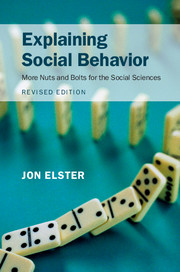II - The Mind
Published online by Cambridge University Press: 05 August 2015
Summary
This book is organized around the “belief–desire model” of action. To understand how people act and interact, we first have to understand how their minds work. This is largely a matter of introspection and folk psychology, refined and corrected by the more systematic studies carried out by psychologists and, increasingly, by behavioral economists. The model is vital not only for explaining behavior, but also for assigning praise, blame, or punishment. Guilt usually presupposes mens rea, intentions and beliefs. Strict liability – guilt assigned merely on the basis of the actual consequences of action – is rare. In fact, sometimes we hold people guilty merely on the basis of intentions even when no consequences follow. Attempted murder is a crime. “Witches,” declared John Donne, “think sometimes that they kill when they do not, and are therefore as culpable as if they did.” “As for witches,” wrote Hobbes, “I think not that their witchcraft is any real power; but yet that they are justly punished, for the false belief they have that they can do such mischief, joined with their purpose to do it if they can.”
The belief–desire model, although indispensable, is fragile. The methods we use to impute mental states to other people do not always yield stable results. If we want to measure the height of a building, it does not matter whether we do it from the roof downward or from the ground upward. In the determination of beliefs and desires, the outcome may depend on such irrelevant factors. Consider, for instance, the idea that people “maximize expected utility” (Chapter 13). To make it precise, we have to assume that they have a clear and stable idea of the value attached to each possible outcome of an action, and of the probability they assign to the occurrence of that outcome. Often that assumption is justified, but sometimes it is not.
Consider first the beliefs of the agent. In eliciting the subjective probabilities an individual attaches to an event, a standard procedure is the following. Beginning with a number p, we ask the person whether he would prefer a lottery in which he gains a certain sum of money with probability p or one in which he gains the same amount if the event in question occurs.
Information
- Type
- Chapter
- Information
- Explaining Social BehaviorMore Nuts and Bolts for the Social Sciences, pp. 55 - 64Publisher: Cambridge University PressPrint publication year: 2015
